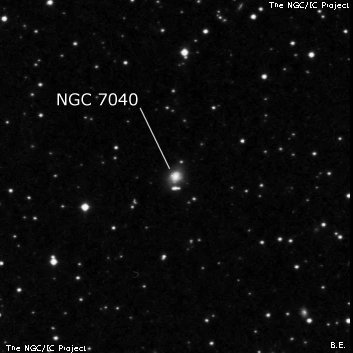
Mark Harrington, director of the Detroit Observatory in Ann Arbor, discovered NGC 7040 on 18 Aug 1882 with a 12 5/8-inch Fitz refractor. His discovery note in AN 2479 mentions "it is so faint that I can only see it after resting my eyes in the dark a few moments. It is about 3' long by half that in breadth and is extended north and south, the northern end preceding a bit." Although the size estimate is too large, his position is a good match with UGC 11701. See Harold Corwin's identification notes.
400/500mm - 17.5" (8/10/91): faint, fairly small, diffuse, oval 3:2 NNW-SSE, low almost even surface brightness. A very faint mag 15.5 star superimposed at the south edge is identified in CGCG and UGC as an extremely compact companion with dimensions 15"x7" but NED notes this may be a close line of three stars.
Forms a pair with MCG +01-54-003 = CGCG 401-006 = PGC 66355 9' SW. This galaxy appeared very faint, very small, round, bright core, faint stellar nucleus. Located almost at the center of a 3' square consisting of four mag 12.5-13.5 stars. In the same 220x field with NGC 7040 9' NE.
17.5" (8/31/86): faint, diffuse, irregularly round, no noticeable core. A faint "star" is embedded on the south edge.
600/800mm - 24" (8/31/16): fairly faint or moderately bright, fairly small, slightly elongated, 25"x20", small brighter nucleus. A mag 15 star is at the south edge of the halo. The SDSS shows an E-W line of 3 faint stars on the south edge, though the middle "star" is classified as a galaxy. CGCG 401-006, located 8.7' SW, appeared fairly faint, small, round, 18" diameter, small bright core, stellar nucleus.
Notes by Steve Gottlieb